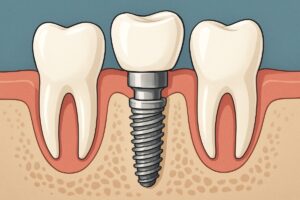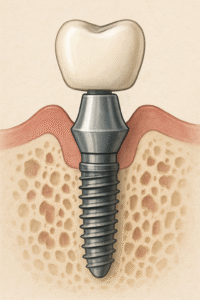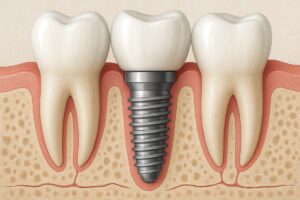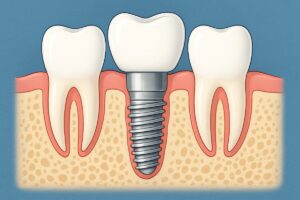A dentistry implant is a small titanium post placed into the jaw to replace a missing tooth root. In 2025, implants matter more than ever because new imaging, materials, and digital workflows make outcomes faster, stronger, and more natural-looking. This guide walks through who is a good candidate, the step-by-step process, implant types and materials, benefits and risks, cost factors and payment options, how to pick a provider, what to expect at your first visit, and next steps to get started.
What Is A Dentistry Implant?
A dentistry implant is a metal post (usually titanium or zirconia) that acts as an artificial tooth root. Main parts include the implant (the screw in the bone), the abutment (connector), and the crown or prosthesis (the visible tooth). Implants restore chewing, speech, and appearance by anchoring crowns, bridges, or full-arch prosthetics without relying on nearby teeth.
Who Is A Good Candidate?
Oral health and bone quality
Good candidates have healthy gums and enough jawbone to support an implant. If bone is thin or missing, bone grafting or ridge augmentation can rebuild support. A dentist uses 3D scans to check bone quantity and plan grafting when needed.
Medical conditions and medications
Certain health issues affect healing. Diabetes, autoimmune disorders, smoking, and some medications (like bisphosphonates) can increase risks. Full medical review and coordination with your doctor help determine if implants are safe for you.
Age, expectations, and lifestyle
Adults of almost any age can get implants if health and bone allow. Candidates should have realistic expectations, be ready for daily care, and commit to follow-up visits. Many older adults achieve excellent long-term results.
The Dentistry Implant Process: Step-by-Step
Consultation and advanced imaging
The process starts with an exam, X-rays, and a CBCT 3D scan to map bone, nerves, and sinuses. Digital impressions from intraoral scanners capture exact tooth positions. This planning improves accuracy and reduces surprises.
Surgical placement and options for sedation
Implants are placed during a minor surgical procedure. Local anesthesia is common; for anxious patients or complex cases, oral sedation or IV sedation is available. Some implants allow immediate placement and temporary teeth, while others use a staged approach.
Healing and osseointegration
After placement, the bone grows around the implant in a process called osseointegration. This usually takes several weeks to months. During healing you’ll follow dietary limits, oral hygiene steps, and follow-up checkups to ensure stability.
Final restoration
Once integrated, an abutment and final restoration (crown, bridge, or full-arch prosthesis) are attached. Restorations can be made from porcelain or zirconia and are cemented or screwed in place. Digital workflows and in-house labs speed up this stage and improve fit.
Types of Dentistry Implants & Restorations
Single-tooth implant
A single implant replaces one missing tooth and preserves neighboring natural teeth. It looks and functions like a normal tooth.
Implant-supported bridge
For multiple missing teeth in a row, an implant-supported bridge uses implants to hold a multi-tooth restoration without shaving down adjacent teeth.
Full-arch solutions (All-on-4 / full-mouth)
Full-arch restorations anchor a complete upper or lower set of teeth to four or more implants. These are recommended for patients with many failing or missing teeth and offer a stable, fixed solution.
Materials: zirconia vs porcelain
Zirconia restorations are extremely strong and stain-resistant, often used for full-arch and implant prosthetics. Porcelain layered over metal or ceramic offers excellent esthetics for single crowns. Choice depends on strength needs, esthetic goals, and cost.
Benefits and Risks
Major benefits: improved chewing and speech, bone preservation, long-term durability, and a natural look. Common risks: infection, implant failure, nerve or sinus complications, and need for additional grafting. Careful planning with CBCT, experienced clinicians, and good oral hygiene reduce most risks.
What Affects Cost & Payment Options
Cost drivers include the number of implants, the need for bone grafts or extractions, materials used, lab work, and whether a specialist is involved. Insurance coverage varies—some plans help with part of the crown or surgical fees, but many do not cover full implant costs. Common payment options include dental financing plans, third-party medical financing, credit, and in-house payment plans.
How To Choose A Provider For Dentistry Implant
Check credentials and years of implant experience. Ask if the provider uses CBCT and intraoral scanners, offers sedation options, and has an in-house lab for faster, controlled restorations. Read patient reviews and ask how complications are handled and what follow-up care is included.
Why Consider Grand Dental Implant Centers
Grand Dental Implant Centers focuses on implant care with decades of experience since 1987. The group uses CBCT imaging, intraoral scanners, soft-tissue lasers, and in-house labs to control quality and speed treatment. Multiple Illinois locations (Aurora, Lake Zurich, Wilmington) offer IV sedation, full-mouth implant options, and financing to make care accessible.
Dr. Cole Wells
Dr. Cole Wells is a lead implant clinician at the Aurora location. He trained at Midwestern University College of Dental Medicine and continues advanced training in complex implant and restorative care. He is a member of the ADA and ISDS.
Dr. Brandon Bice
Dr. Brandon Bice is a general dentist with advanced implant training, focusing on restorative and full-arch implant work. He trained at Midwestern University and holds memberships in the ADA and ISDS.
What To Expect At Your First Visit
Expect intake forms, a dental exam, and a CBCT 3D scan. Your dentist will review treatment options, a likely timeline, sedation choices, and financing. You’ll get a personalized plan and answers to questions about healing and long-term care.
Frequently Asked Questions
Q: Does it hurt?
A: Most patients report manageable discomfort after surgery. Local anesthesia keeps you comfortable during the procedure, and sedation is available.
Q: How long do implants last?
A: With good care, implants can last decades. Crowns may need replacement over time, but the implant itself often lasts a lifetime.
Q: How do I care for them?
A: Brush twice daily, floss or use interdental brushes, and keep regular dental visits. Good oral hygiene prevents infection around implants.
Q: Will insurance pay?
A: Coverage varies. Some plans help with portions of treatment; financing options are commonly used for remaining costs.
Q: How long until I can eat normally?
A: Soft foods are recommended for weeks after surgery. With immediate-load protocols you may have temporary teeth faster, but full chewing on final restorations may take a few months.
Dental implants are a reliable way to restore function, preserve bone, and improve appearance. Advances in imaging, materials, and in-house lab work make 2024 a great time to consider implant care. If you’re thinking about implants, schedule a consultation to get a personalized plan and learn if implants are right for you. Contact Grand Dental Implant Centers to discuss options and financing at a location near you.






